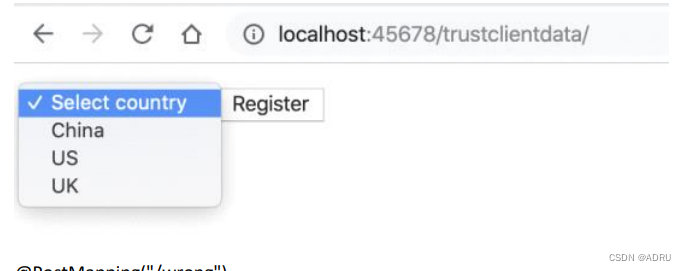项目开发中安全问题以及解决办法——客户请求需要校验
发布时间:2024年01月19日
@Slf4j
@RequestMapping("trustclientdata")
@Controller
public class TrustClientDataController {
//所有支持的国家
private HashMap<Integer, Country> allCountries = new HashMap<>();
public TrustClientDataController() {
allCountries.put(1, new Country(1, "China"));
allCountries.put(2, new Country(2, "US"));
allCountries.put(3, new Country(3, "UK"));
allCountries.put(4, new Country(4, "Japan"));
}
@GetMapping("/")
public String index(ModelMap modelMap) {
List<Country> countries = new ArrayList<>();
//从数据库查出ID<4的三个国家作为白名单在页面显示
countries.addAll(allCountries.values().stream().filter(country -> country.getId()<4).collect(Collectors.toList()));
modelMap.addAttribute("countries", countries);
return "index";
}
}
...
<form id="myForm" method="post" th:action="@{/trustclientdata/wrong}">
<select id="countryId" name="countryId">
<option value="0">Select country</option>
<option th:each="country : ${countries}" th:text="${country.name}" th:value="${country.id}"></option>
</select>
<button th:text="Register" type="submit"/>
</form>
...
比如上面的情况,我们从数据库存储的国家中选择其中三个作为白名单进行展示,选择条件是id<4
前端展示如下:

?正常情况下 用户只能看到id<4的数据
@PostMapping("/wrong")
@ResponseBody
public String wrong(@RequestParam("countryId") int countryId) {
return allCountries.get(countryId).getName();
}
这时候添加了新的网关接口,如果此时用户传入了4 ,比如下面的请求
curl http://localhost:45678/trustclientdata/wrong\?countryId=4 -X POST
?很明显这样就会拿到了不是白名单中的数据
解决办法:
@PostMapping("/right")
@ResponseBody
public String right(@RequestParam("countryId") int countryId) {
if (countryId < 1 || countryId > 3)
throw new RuntimeException("非法参数");
return allCountries.get(countryId).getName();
}
或者使用spring validation,代码如下:
@Validated
public class TrustClientParameterController {
@PostMapping("/better")
@ResponseBody
@ResponseBody
public String better(
@RequestParam("countryId")
@Min(value = 1, message = "非法参数")
@Max(value = 3, message = "非法参数") int countryId) {
return allCountries.get(countryId).getName();
}
}
客户端提交的参数需要校验的问题,可以引申出一个更容易忽略的点是,我们可能会把一些服务端的数据暂存在网页的隐藏域中,这样下次页面提交的时 候可以把相关数据再传给服务端。虽然用户通过网页界面的操作无法修改这些数据,但这些数据对于 HTTP 请求来说就是普通数据,完全可以随时修改为 任意值。所以,服务端在使用这些数据的时候,也同样要特别小心。
文章来源:https://blog.csdn.net/m0_71507863/article/details/135681550
本文来自互联网用户投稿,该文观点仅代表作者本人,不代表本站立场。本站仅提供信息存储空间服务,不拥有所有权,不承担相关法律责任。 如若内容造成侵权/违法违规/事实不符,请联系我的编程经验分享网邮箱:chenni525@qq.com进行投诉反馈,一经查实,立即删除!
本文来自互联网用户投稿,该文观点仅代表作者本人,不代表本站立场。本站仅提供信息存储空间服务,不拥有所有权,不承担相关法律责任。 如若内容造成侵权/违法违规/事实不符,请联系我的编程经验分享网邮箱:chenni525@qq.com进行投诉反馈,一经查实,立即删除!
最新文章